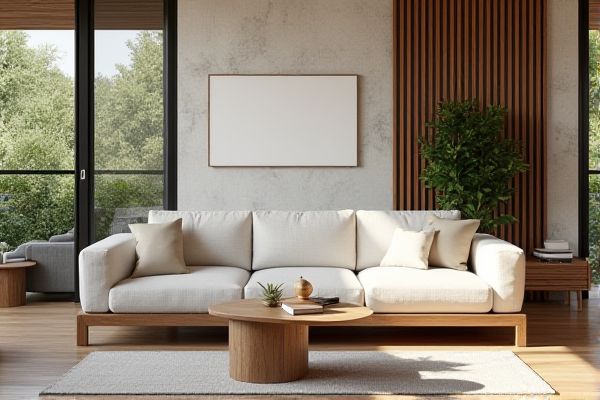
Aluminum furniture offers lightweight durability and resistance to rust, making it ideal for low-maintenance outdoor setups, while teak furniture provides natural beauty and exceptional longevity due to its dense, weather-resistant hardwood. Discover which option best suits Your style and outdoor needs by reading the rest of the article.
Table of Comparison
| Feature | Aluminum Furniture | Teak Furniture |
|---|---|---|
| Material | Lightweight, corrosion-resistant aluminum alloy | Dense, durable hardwood from Tectona grandis tree |
| Durability | Rustproof, weather-resistant, lasts 10-15 years | Highly durable, resists rot and insects, lasts 50+ years |
| Maintenance | Low maintenance, occasional cleaning | Requires periodic oiling and cleaning |
| Weight | Lightweight and easy to move | Heavier and less portable |
| Appearance | Modern, sleek metallic finish | Classic, natural wood grain with warm tones |
| Cost | Generally affordable | More expensive due to wood quality and longevity |
| Environmental Impact | Recyclable, lower environmental footprint | Natural, biodegradable but requires forest resources |
| Comfort | May require cushions for comfort | Comfortable natural feel without cushions |
Introduction to Aluminum and Teak Furniture
Aluminum furniture is lightweight, durable, and resistant to rust, making it ideal for outdoor use and easy maintenance. Teak furniture, prized for its rich golden color and natural oils, offers exceptional durability and weather resistance, developing a beautiful patina over time. Your choice depends on whether you prioritize low maintenance and modern aesthetics or timeless elegance and natural warmth.
Material Composition and Properties
Aluminum furniture features lightweight, corrosion-resistant metal alloy composition ideal for outdoor durability and easy maintenance, while teak furniture is crafted from dense hardwood renowned for its natural oils that provide resistance to rot, insects, and weathering. The metal's heat reflectivity and rigidity contrast with teak's warmth, flexibility, and ability to develop a distinctive patina over time. Your choice depends on preferences for material longevity and aesthetic qualities in different environmental conditions.
Durability and Longevity Comparison
Aluminum furniture offers exceptional durability due to its resistance to rust, corrosion, and weather exposure, making it ideal for outdoor use in humid or coastal environments. Teak furniture is renowned for its natural oils and dense grain, providing remarkable longevity and resistance to rot, insects, and decay, often lasting several decades with minimal maintenance. Both materials excel in durability, but teak's ability to withstand harsh climates without coatings and aluminum's low maintenance requirements create distinct advantages depending on environmental conditions.
Weather Resistance: Aluminum vs Teak
Aluminum furniture offers superior weather resistance due to its corrosion-resistant properties, making it ideal for outdoor use in humid or rainy climates. Teak furniture, while naturally weather-resistant because of its dense oily grain, requires periodic maintenance to prevent cracking and discoloration from prolonged sun exposure. Your choice depends on whether you prioritize low-maintenance durability with aluminum or the classic, natural appeal of teak that needs occasional care.
Maintenance Requirements
Aluminum furniture requires minimal maintenance due to its corrosion-resistant properties, needing only occasional cleaning with mild soap and water to retain its appearance. Teak furniture demands regular upkeep, including periodic oiling or sealing to preserve its natural oils and prevent weathering or cracking. The lower maintenance burden of aluminum makes it a practical choice for outdoor use compared to the high durability but more labor-intensive care of teak.
Design Versatility and Aesthetics
Aluminum furniture offers superior design versatility with its lightweight structure allowing for intricate shapes and modern, sleek aesthetics that complement contemporary outdoor spaces. Teak furniture is prized for its rich, warm tones and natural grain patterns, providing a timeless, classic appeal that enhances traditional and rustic settings. While aluminum can be powder-coated in various colors for customization, teak's durability and natural weather resistance contribute to its enduring beauty and elegance.
Environmental Impact and Sustainability
Aluminum furniture offers a sustainable option due to its recyclability and lower carbon footprint compared to teak, which involves deforestation concerns and longer regrowth periods. Teak furniture is durable and biodegradable but raises significant environmental impact issues through habitat loss and illegal logging in tropical forests. Choosing aluminum furniture supports eco-conscious decisions by reducing reliance on endangered hardwoods while maintaining durability and design versatility.
Cost Analysis: Aluminum vs Teak Furniture
Aluminum furniture generally offers a more affordable option compared to teak furniture, with prices often 40-60% lower due to lower material and manufacturing costs. While teak furniture demands higher initial investment for its premium hardwood quality and natural durability, it boasts excellent longevity, often lasting over 50 years with minimal maintenance. The lower upfront cost of aluminum is offset by potential shorter lifespan and susceptibility to corrosion, making cost analysis crucial based on intended use and budget.
Suitability for Different Outdoor and Indoor Settings
Aluminum furniture excels in outdoor settings due to its lightweight, rust-resistant, and low-maintenance properties, making it ideal for patios, poolside, and coastal areas. Teak furniture, with its natural oils and sturdy hardwood, is highly durable and resistant to weather, suitable for both outdoor garden spaces and elegant indoor environments like living rooms or sunrooms. Your choice depends on whether you prioritize modern, easy-care pieces or timeless, natural aesthetics that age beautifully over time.
Final Recommendations and Conclusion
Aluminum furniture offers superior durability, lightweight convenience, and low maintenance, making it ideal for modern outdoor settings and urban environments. Teak furniture provides unmatched natural beauty, longevity, and resistance to weather through its dense oils and tight grain, preferred for classic and rustic aesthetics. Choosing between aluminum and teak depends on priorities: opt for aluminum for ease of care and modern style, or teak for timeless elegance and enduring strength.
 homyna.com
homyna.com